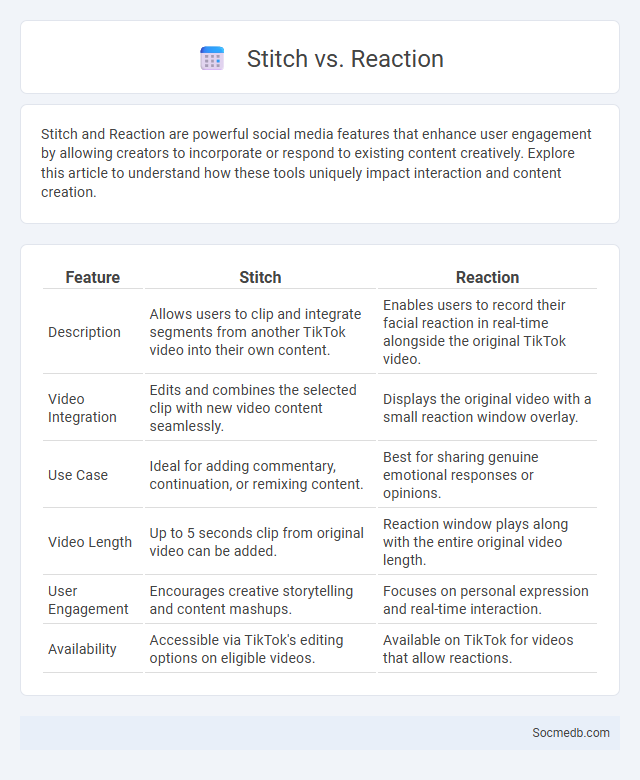
Photo illustration: Stitch vs Reaction
Stitch and Reaction are powerful social media features that enhance user engagement by allowing creators to incorporate or respond to existing content creatively. Explore this article to understand how these tools uniquely impact interaction and content creation.
Table of Comparison
| Feature | Stitch | Reaction |
|---|---|---|
| Description | Allows users to clip and integrate segments from another TikTok video into their own content. | Enables users to record their facial reaction in real-time alongside the original TikTok video. |
| Video Integration | Edits and combines the selected clip with new video content seamlessly. | Displays the original video with a small reaction window overlay. |
| Use Case | Ideal for adding commentary, continuation, or remixing content. | Best for sharing genuine emotional responses or opinions. |
| Video Length | Up to 5 seconds clip from original video can be added. | Reaction window plays along with the entire original video length. |
| User Engagement | Encourages creative storytelling and content mashups. | Focuses on personal expression and real-time interaction. |
| Availability | Accessible via TikTok's editing options on eligible videos. | Available on TikTok for videos that allow reactions. |
Introduction to Stitch, Reaction, and Reaction Videos
Stitch is a popular social media feature that allows you to clip and integrate segments of other users' videos into your own content, enabling creative interactions across platforms. Reaction videos capture authentic emotional responses, often enhancing viewer engagement by presenting genuine feedback or commentary. Your ability to combine Stitch with reaction videos can amplify connection and storytelling, driving dynamic content creation and social sharing.
Defining Stitch Content: Formats and Features
Stitch content on social media refers to a format that allows users to integrate and respond to existing videos by clipping and adding their own commentary or reactions, primarily popularized by TikTok. This feature enhances creative interaction by enabling seamless blending of multiple video narratives within a single post, increasing engagement and content diversity. Formats include short clips, direct replies, and visual overlays, often with tools for trimming, audio synchronization, and text enhancements to deliver concise, impactful storytelling.
What is a Reaction Video? Key Characteristics
A reaction video is a type of content where creators film their immediate responses to various media such as movies, music, or viral clips, capturing genuine emotions and thoughts. Key characteristics include authentic facial expressions, spontaneous commentary, and viewer engagement through relatable reactions. These videos often foster community interaction by encouraging audiences to share their own opinions and experiences in the comments.
Comparing Stitch and Reaction Videos: Core Differences
Stitch videos integrate a specific segment of another creator's content directly into the new video, allowing for creative dialogue and context building, while reaction videos capture an individual's real-time emotional and verbal response to existing content without altering the original footage. Stitch encourages collaboration by blending original and borrowed clips, enhancing interactivity and narrative expansion, whereas reaction videos emphasize personal perspective and audience connection through spontaneous feedback. Both formats leverage user engagement but differ fundamentally in content manipulation and viewer experience on platforms like TikTok and YouTube.
Evolution of Reaction Content: From Simple Reactions to Stitching
The evolution of reaction content on social media showcases a shift from simple likes and emojis to more complex interactions like stitching, where users creatively collaborate by incorporating others' videos into their own. This transition enhances engagement, allowing Your responses to become dynamic narratives that add context and personal perspective. Platforms like TikTok and Instagram have popularized this trend, turning passive reactions into active storytelling tools that drive viral content and community participation.
Popular Platforms for Stitch and Reaction Videos
TikTok and Instagram are the most popular platforms for stitch and reaction videos, leveraging their extensive user bases and interactive features. TikTok's native "Stitch" function allows users to clip and respond to segments of other videos, fostering viral trends and collaborative content creation. Instagram Reels similarly supports reaction videos through its remix feature, enabling users to engage with content seamlessly while boosting audience interaction.
Audience Engagement: Stitch vs Reaction vs Reaction Videos
Stitch, Reaction, and Reaction Videos each offer unique methods for audience engagement on social media, boosting interaction and content virality. Stitch enables users to clip and integrate parts of others' videos, fostering creative collaboration and driving community participation. Reaction and Reaction Videos trigger emotional responses and encourage sharing, amplifying viewer engagement through authentic, relatable content.
Creative Uses and Trends in Stitch and Reaction Videos
Stitch and reaction videos have transformed social media engagement by enabling users to creatively interact with existing content, fostering dynamic conversations and community building. You can leverage these formats to showcase unique perspectives, enhance storytelling, and capitalize on trending topics to boost visibility and audience interaction. This growing trend harnesses the power of collaboration and real-time feedback, driving viral potential and shaping the future of content creation across platforms like TikTok and Instagram Reels.
Intellectual Property and Fair Use in Stitch and Reaction Content
Social media platforms, especially those enabling Stitch and reaction content, elevate complex Intellectual Property challenges as users incorporate copyrighted materials from original creators. Fair Use doctrine permits limited use of copyrighted works without permission, emphasizing purposes like commentary, critique, or transformation, yet interpretation varies widely across jurisdictions. Creators and platforms must navigate balancing user creativity with protecting original content owners' rights to mitigate infringement risks and maintain compliance.
Future Outlook: The Next Phase for Reaction-Based Content
Reaction-based content on social media is evolving with AI-driven personalization and real-time engagement metrics shaping user interactions. Platforms are leveraging machine learning to predict your emotional responses, increasing content relevance and fostering deeper community connections. This next phase promises more immersive experiences through augmented reality and interactive features that respond dynamically to user feedback.
 socmedb.com
socmedb.com